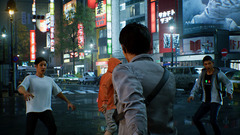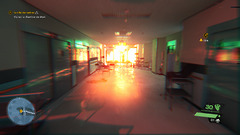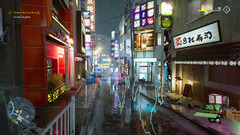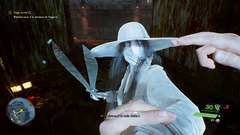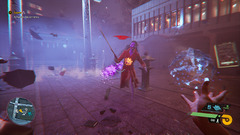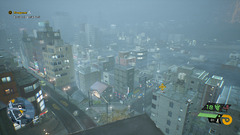Night walks
Akito, a hero in spite of himself, finds himself possessed by the ghost of a former detective, the aptly named KK. This gives him supernatural powers, on the condition that he helps him in his quest against a deep evil that seems to want to take hold of Tokyo. Meanwhile, Akito goes in search of his hospitalized sister Mari, who has disappeared as ghosts and other yokai take over a Tokyo shrouded in an eerie fog. We have to admit it, Ghostwire: Tokyo usually struggles to captivate with its story. The fault of a rather limited characterization of his hero, literally a puppet of the ghost KK, while the latter has rather limited objectives: to go straight and hit the ghost who took his life. The narration also suffers from a weak staging, as well as secondary characters who are at best forgettable, at worst frankly missed. There are, however, some good ideas: the cooperation between Akito and KK is sometimes successful, especially when their goals align, or the rare times when one opens up to the other by telling his past and his hopes for the future. ‘to come up. Small moments where the narration allows itself a certain tenderness, with characters who open up and reveal themselves, in the middle of a city of Tokyo with terribly gloomy looks, especially when the game takes us to its depths.
And that’s the strength of the game. If its narration struggles to take off, it’s the very special atmosphere of the Tokyo imagined by Tango Gameworks which makes us want to move forward and discover more and more. We discover a unique and absolutely captivating atmosphere, the game takes us and does not release us until about ten hours later in the face of the credits (or rather twenty if you do the many – but not very exciting – secondary quests). We take pleasure in discovering the city and revealing all its aspects, purifying the many torii scattered in Tokyo, allowing to move away the fog within which one cannot survive (yes, it is a little the radio towers of the game). Each time you push back the fog, you discover new neighborhoods with very different atmospheres, from the beginnings at Shibuya Crossing to more traditional-looking residential areas, passing through arcades and a gigantic park. . More fascinating than horrific, the atmosphere of the game uses the myths of Japanese horror to tell a fantastic-looking city, where neon lights mingle with more mystical effects around the appearance of ghosts (lights that flash , cloud that envelops the neighborhood, sudden wind…) and it works terribly well. An atmosphere enhanced by the use of the DualSense controller on playstation5taking advantage of both haptic feedback and the built-in speaker to improve immersion, giving the feeling of being there and that KK is actually whispering in our ears.
The city is paradoxically alive when everyone has disappeared, thanks to the presence of enemies but above all to the many ghosts of deceased inhabitants who tell us their story, their last moments, the moment when everything changed. If it’s not always very well written, it gives a certain consistency to a city which becomes a character in its own right, the real strength of a game which nevertheless struggles on many other things. To this, we add the verticality of the city and the ease of moving, of jumping from roof to roof or of going in the underground galleries of the metro and this gives this Tokyo something captivating, almost mystical, with an oppressive atmosphere that nevertheless makes you want to move forward ever further. This care for the city clashes with the relatively sloppy storytelling, but it makes the game thoroughly enjoyable.
Intense but weak
If there’s one thing Ghostwire: Tokyo achieves in its gameplay, is its intensity. The use of different powers (wind, water, fire) that are thrown in the face (or body, when they have no head) of ghosts in the manner of energy balls is quite exhilarating. The passage from one element to another is done simply, either with a button to move on to the next or with a selection wheel, while the powers are recharged by killing enemies or by destroying particular decorative elements. Thus, the game always encourages going towards the attack while remaining very mobile, because the enemies are also rather lively and can hurt a lot, so much so that in the normal difficulty mode the game can sometimes be quite difficult, forcing to be careful never to be overwhelmed. Since the resistance of the hero is not very high (and the use of healing is limited in time), it is better to avoid confrontation in melee. Especially since some enemies can dissociate Akito from KK, in sequences where the hero thus loses all his powers, then having a not very terrible bow as his only weapon, until we manage to recover KK at the using a QTE where one is completely defenseless for a few moments.
However, it must be admitted that these sequences are less good. If they allow to spice up certain fights where one avoids at all costs to be caught and to undergo this dissociation which puts us practically without defense vis-a-vis the ghosts, they are also sometimes imposed by the narration. And these imposed sequences push the gameplay towards a mixture of infiltration and discrete arc murders, rather missed moments and not very interesting to play, the fault of a AI quite basic and at a level design that adapts quite badly. With the exception of a boss fight which revolves entirely around this, the staging of which is rather nice, but which becomes quite trivial once we have found the trick to get rid of it without any risk. . As for the progression system, the game revolves around level passages that unlock skills. Nothing very original on this side, with skills that consist of either strengthening attack powers or strengthening the hero, in particular his ability to steal the “heart” of ghosts as quickly as possible, sort of finisher that you can perform on ghosts to make them disappear when you manage to weaken them.
Nevertheless, it is in its way of gaining levels that the game is rather good, since if it is fairly low-paying during combat, through exploration we see our experience counters explode. Exploration makes it possible to come face to face with ghosts of inhabitants who are stuck between life and beyond, which can be recovered and stored via an artifact before being able to “deliver” them by unloading them by means of telephone booths that can be found on every street corner. If the way to proceed is rather funny, it nevertheless strongly encourages exploration, since each new area that we discover, each roof on which we climb, each alley where we walk is likely to pay us in experience. Even if it means becoming too powerful for the main quest after a while if you get caught up in the game and end up exploring the whole map instead of advancing in the story. However, this is not a bad thing: the fights are so repetitive in the long run, the fault of a limited number of powers which only evolve very little, that we end up being very happy to be powerful enough for them. ship as fast as possible in the final third of the game.
Beauty has its limits
The artistic direction sublimates this city that we have a thousand reasons to explore. If it’s not to gain experience or complete a quest, it’s simply to see what visual idea will hide behind the next alley. We have already talked about neon lights, but it would be simplistic to limit ourselves to that. A gigantic shopping center, temples, streets where life seems to have stopped with clothes thrown on the ground as bodies suddenly disappeared, an abandoned stroller or a stray dog being given kibble recovered earlier, so many little things that sublimate a city whose secrets are many. It’s visually impressive, yet the game has nothing to do with a “graphic slap” as it is often said, but there is a real coherence in what is shown, even if this Tokyo sometimes looks like a kind of map post office of a city that we fantasize. My only regret on the artistic aspect is related to the music, quite absent and secondary, while the game offers real moments of contemplation where we would have liked a more present musical atmosphere. However, the game compensates with a successful sound design, with some frankly disturbing noises that reinforce the mystical side of the city.
And fortunately the artistic direction of the game does the job, because it is on its technical aspect that Ghostwire: Tokyo completely fails. Tested on PlayStation 5, the game suffers from drops of frame rate considerable regardless of the performance mode chosen. This makes vertical exploration in particular less interesting, because it is in these moments, when we have the city in front of us, that the game suffers the most. However, the developers of Tango Gameworks have pulled out all the stops by offering nothing less than six graphics modes: a rather classic fidelity mode (30fps) and performance mode (60fps), and then four “high performance” modes oriented either to the graphics or the frame ratewith or without vertical synchronization (vsync) and by offering each time frame rate unlocked. The problem is that this frame rate unlocked causes in modes without vsync a tearing important, while with vsync, the game suffers from very noticeable latency between the moment a button is pressed and the moment the action takes place on screen. If we recommend the performance mode instead, as the “high performance” modes are difficult to play, this one does not maintain the 60 fps and suffers from many drops. The game then raises the question of the support of VRR by the PlayStation 5 which could have solved the concerns of tearing : it was finally announced by sony at the end of March for a future update, but we would like it to be available and supported by Ghostwire already so that these unlocked framerate modes finally become relevant.
Conclusion
Ghostwire: Tokyo seduces as much as it frustrates. With a city with a neat atmosphere, constantly giving the desire to explore and even offering a memorable stroll within a Tokyo with a mystical tone, the game also suffers from a narration below expectations, never really interesting or relevant, with characters that we quickly forget. However, during the ten hours that the main quest lasts, we constantly want to come back to it, to see more and more, and this is perhaps where the game succeeds. At a time when so many action games choose the open world by default, because it absolutely needs a lot of map in order not to look too broke in the face of competitors while satisfying players’ desires for freedom, Ghostwire: Tokyo manages the feat of not making its open world a mere gimmick, but a central element that justifies he alone has the desire to play there and to return there again and again, so much his city is full of secrets and beautiful ideas. Imperfect, too rough on many points, the game of Tango Gameworks manages at least to offer a unique world.
Test conducted by Hachim0n on PlayStation 5 from a version provided by the publisher.
.
The post Ghostwire: Tokyo – Ghostwire: Tokyo Review – A Liberating Death appeared first on Gamingsym.

